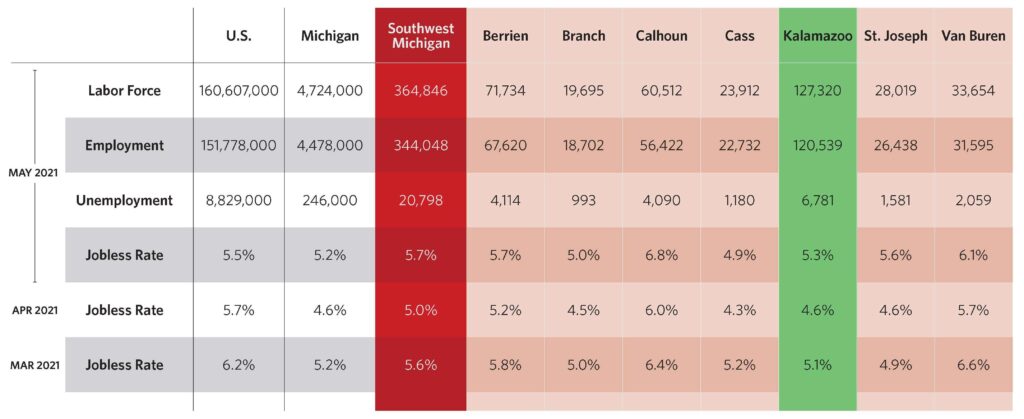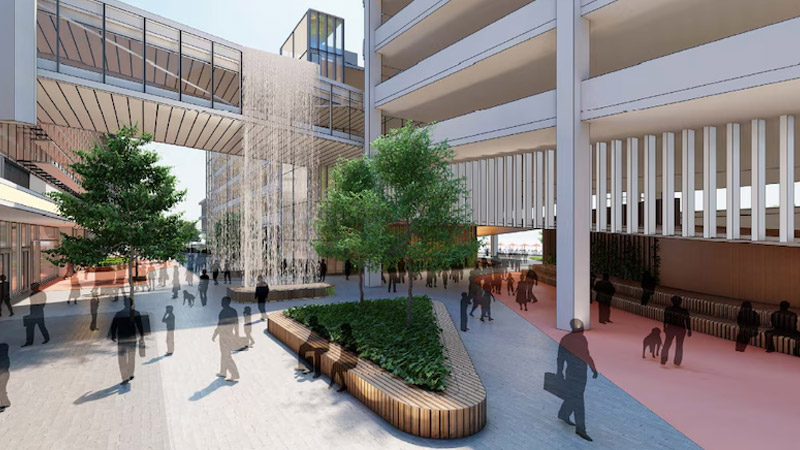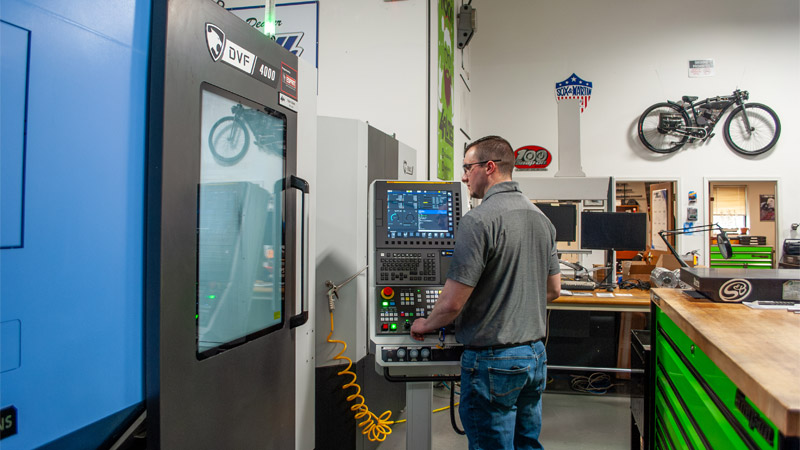Not seasonally adjusted jobless rates rose in 14 of Michigan’s 17 major labor market areas between April and May, according to data released from the Michigan Department of Technology, Management & Budget (DTMB). “Michigan regional jobless rate gains in May were often due to an increase in the number of persons active in the labor force,” said Wayne Rourke, associate director of the Bureau of Labor Market Information and Strategic Initiatives. “Payroll employment advanced in May in most metro areas.” When breaking the numbers down by county, the combined not seasonally adjusted May 2021 jobless rate of 5.7 percent for the seven-county Southwest Michigan region was up 0.7 percentage points from April 2021. Among regional counties, Cass posted the lowest seasonally unadjusted unemployment rate in May 2021 at 4.9 percent, followed by Branch County with a rate of 5.0 percent, and Kalamazoo County with a rate of 5.3 percent. All counties had increased jobless rates over the month.
Visit the DTMB’s site to see rankings by county, county labor force numbers, and an overall snapshot of Michigan’s employment or download a summary report here provided by local economic development catalyst Southwest Michigan First.
The National Outlook
The national unemployment rate in May 2021 was 5.5 percent, not seasonally adjusted, which represents a 7.5 percentage point drop from the previous year and a 0.6 percentage point drop from the previous month. There were 247 metro areas with unemployment rates below the U.S. average, 131 areas with rates above it, and 11 areas with rates equal to the national average. Year over year, unemployment rates were lower in all 389 metropolitan areas. The MSA with the highest unemployment rate in the country for May 2021, not seasonally adjusted, was Yuma, AZ, with a rate of 17.0 percent. The lowest not seasonally adjusted unemployment rate was recorded in Burlington-South Burlington, VT at 1.2 percent.
The ADP® National Employment Report™ confirmed 978,000 jobs were added to private-sector employment from April to May, on a seasonally adjusted basis. Of those, 850,000 came from the service-providing sector driven predominantly by leisure and hospitality (440,000 jobs). The remaining 128,000 were from the construction (65,000 jobs), manufacturing (52,000 jobs), and natural resources and mining (11,000 jobs).
Here in Michigan
The state of Michigan posted a not seasonally adjusted May 2021 unemployment rate of 5.2 percent, 0.3 percentage points below the national average. This represents a 0.6 percentage point increase from April 2021’s rate of 4.6 percent, and a 15.9 percentage point decrease from May 2020, when a rate of 21.1 percent was recorded. For Michigan MSAs, Detroit-Warren-Dearborn had the lowest unemployment rate in May 2021 at 4.6 percent. Ann Arbor and Grand Rapids-Wyoming was close behind with rates of 4.9 percent. Muskegon had the highest unemployment rate in May 2021 at 7.9 percent, followed by Flint, with a rate of 7.5. All 14 Michigan MSAs had an increased unemployment rate over the month.
The Regional Labor Market Picture
Here is the data breakdown on the region’s three labor markets which are the Kalamazoo-Portage, MI MSA, Battle Creek, MI MSA, and Niles-Benton Harbor MSA.
- The Kalamazoo-Portage, MI MSA’s unemployment rate of 5.5 percent in May 2021 was up 0.7 percentage points from the rate in April 2021 of 4.8 percent. This is, however, a 12.2 percentage point reduction from the rate a year ago in April 2020, which recorded a rate of 17.7 percent. While this MSA did record the same unemployment rate as the national average, it is 0.3 percentage points above Michigan’s average of 5.2 percent. The number of unemployed persons in the MSA increased by 1,053 from April 2021 (7,787 unemployed persons) to May 2021 (8,840 unemployed persons). The total civilian labor force grew over the month by 356 persons from 160,618 in April 2021 to 160,974 in May 2021. Back in May 2020, the total civilian labor force was 166,574. At the height of the unemployment effects due to COVID-19 in April 2020, the Kalamazoo-Portage, MI MSA had an unemployment rate of 18.0 percent, with 28,322 unemployed persons and a total civilian labor force of 157,198. Over the course of 13 months to May 2021, the MSA has seen a 12.5 percentage point reduction in its unemployment rate, a reduction in the number of unemployed persons by 19,482, and a gain of 3,776 in total civilian labor force.
- In March 2021, the Battle Creek, MI MSA posted an unemployment rate of 6.8 percent, a rate 0.8 percentage points higher than it was in April 2021 at 6.0 percent. This is a 15.0 percentage point decrease from a year ago in May 2020, when an unemployment rate of 21.8 percent was recorded. This MSA’s unemployment rate is 1.3 percentage points higher than the national average, and 1.6 percentage points above Michigan’s unemployment rate of 5.2 percent. The number of unemployed persons in the Battle Creek, MI MSA grew by 544 from April 2021 (3,546 unemployed persons) to May 2021 (4,090 unemployed persons). The MSA’s total civilian labor force grew over the month by 1,101 persons from 59,411 in April 2021 to 60,512 in May 2021. The total civilian labor force was 64,267 in May 2020. At the height of the unemployment effects due to COVID-19 in April 2020, the Battle Creek, MI MSA had an unemployment rate of 24.6 percent, with 14,884 unemployed persons and a total civilian labor force of 60,383. Over the course of 13 months to May 2021, the MSA has seen a 17.8 percentage point reduction in the unemployment rate, a drop in the number of unemployed persons by 10,794, and an increase of 129 in total civilian labor force.
- The Niles-Benton Harbor, MI MSA’s unemployment rate of 5.7 percent for May 2021 was 0.5 percentage points higher than its 5.2 percent April 2021 rate. This is a 12.9 percentage point decrease from a year ago in May 2020, when unemployment was recorded at 18.6 percent. The MSA’s unemployment rate is 0.2 percentage points above the national average and is 0.5 percentage points above Michigan’s rate of 5.2 percent. The number of unemployed persons in this MSA dropped by 449 from April 2021 (3,665 unemployed persons) to May 2021 (4,114 unemployed persons), while its total civilian labor force grew over the month by 1,352 persons from 70,382 in April 2021 to 71,734 in May 2021. The total civilian labor force was 72,504 in May 2020. At the height of the unemployment effects due to COVID-19 in April 2020, this MSA had an unemployment rate of 20.0 percent, with 14,107 unemployed persons and a total civilian labor force of 70,427. Over the course of 13 months to May 2021, Niles-Benton Harbor, MI MSA has seen a 14.3 percentage point reduction in the unemployment rate, a reduction in number of unemployed persons by 9,993, and a gain of 1,307 in total civilian labor force.
County by County: Cass, Branch, and Kalamazoo Anchor Regional Picture
When breaking the numbers down by county, the combined not seasonally adjusted May 2021 jobless rate of 5.7 percent for the seven-county Southwest Michigan region was up 0.7 percentage points from April 2021. Among regional counties, Cass posted the lowest seasonally unadjusted unemployment rate in May 2021 at 4.9 percent, followed by Branch County with a rate of 5.0 percent, and Kalamazoo County with a rate of 5.3 percent. All counties had increased jobless rates over the month. St. Joseph County had the highest increase, which expanded by 1.0 percentage point, followed by Calhoun County, which expanded by 0.8 percentage points.
The region recorded a total labor force of 364,846 in May 2021, representing a 3,887-person expansion from the 360,959-person labor force in April 2021. Employed persons also grew by 1,245 over the month from 342,803 in April 2021 to 344,048 in May 2021. The number of unemployed persons grew by 2,642 over the month from 18,156 in April 2021 to 20,798 in May 2021.
At peak COVID-19 disruptions in April 2020, the seven-county region had 74,851 unemployed persons with a labor force of 357,815 and 282,964 employed persons. This represented an aggregate unemployment rate of 20.9 percent. Over the 13 months since May 2020, the seven-county region has seen a reduction in unemployment rate of 15.7 percentage points. The region has also seen a reduction of unemployed persons by 54,053, an increase in employed persons by 61,084, and an increase in labor force by 7,031 persons.

Source: Michigan DTMB: Michigan Bureau of Labor Market Information and Strategic Initiatives, Local Area Unemployment Statistics (LAUS), May 2021. Notes: All estimates are preliminary. Data is not seasonally adjusted.




